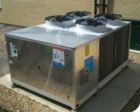Arguing the case for high temperature heat pumps

Garry Broadbent argues the case for high-temperature heat pumps in opening up the market by producing DHW at higher temperatures and serving buildings where medium-temperature heat pumps are not appropriate.
As the heat-pump market moves forward we are seeing a growing debate concerning the application and use of high-temperature air-source heat pumps. The question being asked is whether it is acceptable to install a heat pump operating at a higher temperature, with an obvious reduction in COP compared to a medium-temperature system?
The recent launch of the heat-pump emitter guide highlights the importance of the distribution system for efficient operation. It is becoming common knowledge that the design and selection of the emitter system is the key to ensuring efficient heat-pump performance utilising medium-temperature systems.
However the specific demands of the application will determine how practical it will be to carry out emitter modifications on a retrofit application to allow for a medium temperature 45°C flow.
A new-build project is straightforward but we must consider the practical use of heat pumps for retrofit.
In general the industry is targeting a seasonal system COP of around 2.9, which should be achievable on either a retrofit or new-build application provided the specifier/installer considers the basic design requirements.
To apply heat pumps on a wider basis to both the retrofit and the new-build sectors it is clear that high-temperature capability will offer benefits by enabling the demands of each project to be met by applying the most suitable heat pump, either medium or high temperature.
Our market presents heat-pump specifiers and installers with two main challenges.
First, we have a winter climate which calls for heat pumps to operate from 10°C to -15°C. Second, our main target market is retrofit, which is unpredictable in terms of building performance and heat loss. Medium-temperature heat pumps restrict the market potential.
Medium temperature heat pumps provide an output temperature of around 45°C in an ambient of -5°C, whereas high-temperature heat pumps provide an output in excess of 60°C at the same ambient.
The next question is the efficiency of high-temperature heat pumps at an output temperature of 60°C. The expected answer may be that the heat pump efficiency could be too low to be acceptable. However this is not necessarily so; for example the ICS range of Air Source PRANA HT units will provide a COP in excess of 2.2 when operating at a 60°C flow in an ambient of -5°C.
 |
| This installation of two 20 kW DeLonghi HT air-source heat pumps supplied by ICS provides heating and hot water to a large superstore. |
The same heat pump would provide a COP of 3.2 with an ambient of 2°C and a flow temperature of 50°C. With weather compensation, such a heat pump would provide acceptable efficiency over a full heating season.
The main point to understand, though, is that with some heat-emitter systems, especially in retrofit projects, a flow temperature of 45 to 50°C would be inadequate at an ambient temperature of -5°C.
To develop the potential of the retrofit market our industry must remove as many barriers as possible to encourage market growth. High-temperature heat pumps provide a means of accessing this significant retrofit market on both a residential and commercial basis.
However an underlying concern here is the risk of high-temperature heat pumps being seen as a means of approaching a project without any diligence or improvements to the existing emitter system. For example, the heat pump could be set at a 65°C flow temperature with no regard to system efficiency. Even if guidelines and seasonal COP targets are introduced with initiatives such as the RHI, there is still the risk that the specifier/ installer may not consider the exacting requirements of a retrofit application.
Our industry must therefore be diligent at every level to ensure that the risk of misapplication is continually challenged and reduced.
Hence high-temperature heat pumps are a natural step forward for retrofit heating applications and simply part of the overall heat-pump mix. However such heat pumps are particularly attractive to the specifier/installer who is targeting this potentially lucrative retrofit market.
Another potential market for high-temperature heat pumps is to produce domestic and sanitary hot water. It is now becoming accepted that high-temperature heat pumps deal very directly with the question of a simple solution to providing domestic/sanitary hot water.
Unlike medium-temperature units (48°C at -3°C ambient), high-temperature heat pumps can provide stored water at over 55°C.
In addition commercial European-manufactured CO2 heat pumps such as the ICS Enex unit will provide flow temperatures of over 80°C and are designed to work with intelligent storage systems to create a thermal battery of up to 6000 l.
The principle is that the system can be charged using low cost/low carbon electricity and achieve annual COP levels of over 4 when operating every day of the year.
All this means that high-temperature heat pumps are here to stay!
Whether we are referring to a 9 kW domestic unit or a 400 kW commercial package, there is a heat pump available to suit the most demanding of high-temperature applications.
When specified and installed correctly, these heat pumps provide an excellent alternative to other forms of heating and can deliver significant cost and carbon savings to commercial and residential users.
Specifiers and installers can now make choices to provide the best solution to the market, enabling them to grow their business by offering high-temperature heat pumps to applications that may previously have been out of limits if the only option had been medium temperature.
Garry Broadbent is a director with ICS Heat Pump Technology. He is also a member of the MCS Heat Pump Working Group and an active member of the Heat Pump Association.








